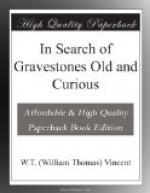Professor Stuart indeed declares that there is no custom in the history of human progress which serves so much to connect the remote past with the present period as the erection of pillar stones. We meet with it, he says, in the infancy of history, and it is even yet, in some shape or other, the means by which man hopes to hand down his memory to the future. The sculptured tombs of early nations often furnish the only key to their modes of life; and their memorial stones, if they may not in all cases be classed with sepulchral records, must yet be considered as remains of the same early period when the rock was the only book in which an author could convey his thoughts, and when history was to be handed down by memorials which should always meet the eye and prompt the question, “What mean ye by these stones?”
To such remote antiquity, however, it is probably undesirable to follow our subject. It will no doubt be thought sufficient for this essay if we leave altogether out of view the researches which have been made in the older empires of the earth, and confine ourselves to the records of our own country. Of these, however, there are many, and they are full of interest. In date they probably occupy a period partly Pagan and partly Christian, and it has been conjectured that all or most of those discovered had their source in Ireland, with a possibility of an earlier importation into Ireland by Icelandic, Danish, or other peoples. Many of these stones have been found buried in the ruins of old churches, and most of them may be supposed to owe their preservation to some such protection. The drawings of one or two may be given as samples. Those here sketched (Figs. 100 and 101) are in the National Museum of Antiquities of Scotland, and occupy with others a considerable space, being well displayed to shew the inscriptions on both sides.[17] It is by the fact of both sides being written upon that we assign to them the character of gravestones, that is upright gravestones; but it is also well authenticated by historical records that the memorial of a Pagan chief in Ireland was a cairn with a pillar stone standing upon it, and there is little doubt that the Irish invaders carried the practice with them into Scotland. It is indeed in Scotland that a large proportion of these stones have been discovered, and there are more than a hundred of them in the Edinburgh Museum. In the Museum at Dublin there is also a good collection, conveniently arranged; but the British Museum in London has less than half a dozen—only five—specimens. The number in each of the three museums fairly represents the relative abundance of such remains in England, Scotland, and Ireland. Marked on a chart the discoveries are thickly grouped in the North-Western parts of Scotland, in the South of Ireland, and on the South-Western promontory of Wales. In Cornwall and Devonshire, along the coast line, there have been found a goodly few, and the others are dotted sparsely over the whole kingdom—England, as just indicated, furnishing only a modicum.




